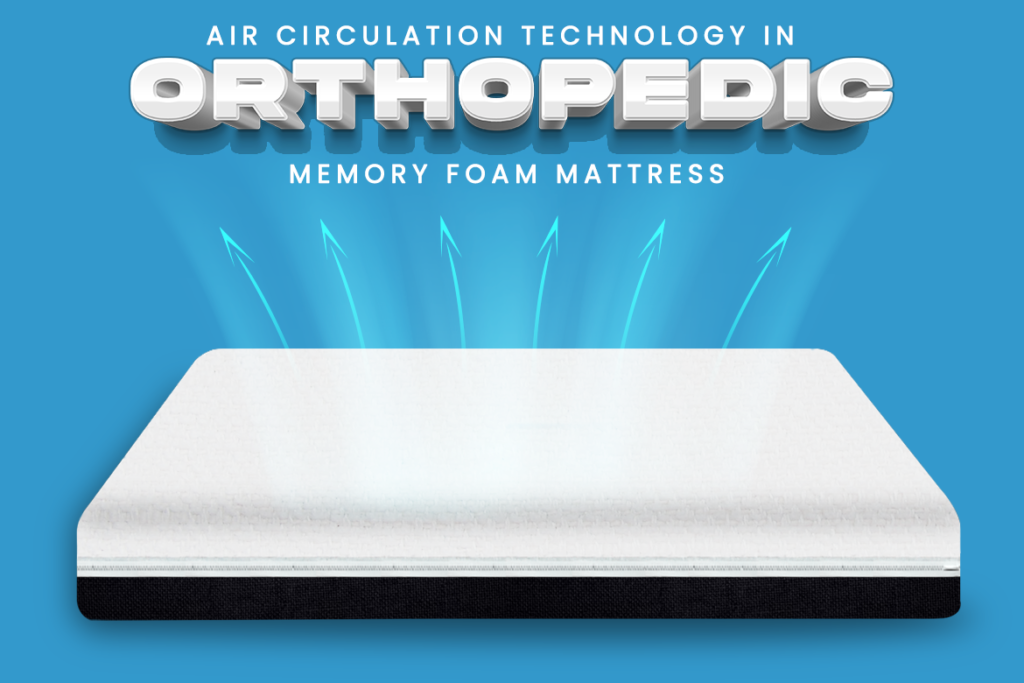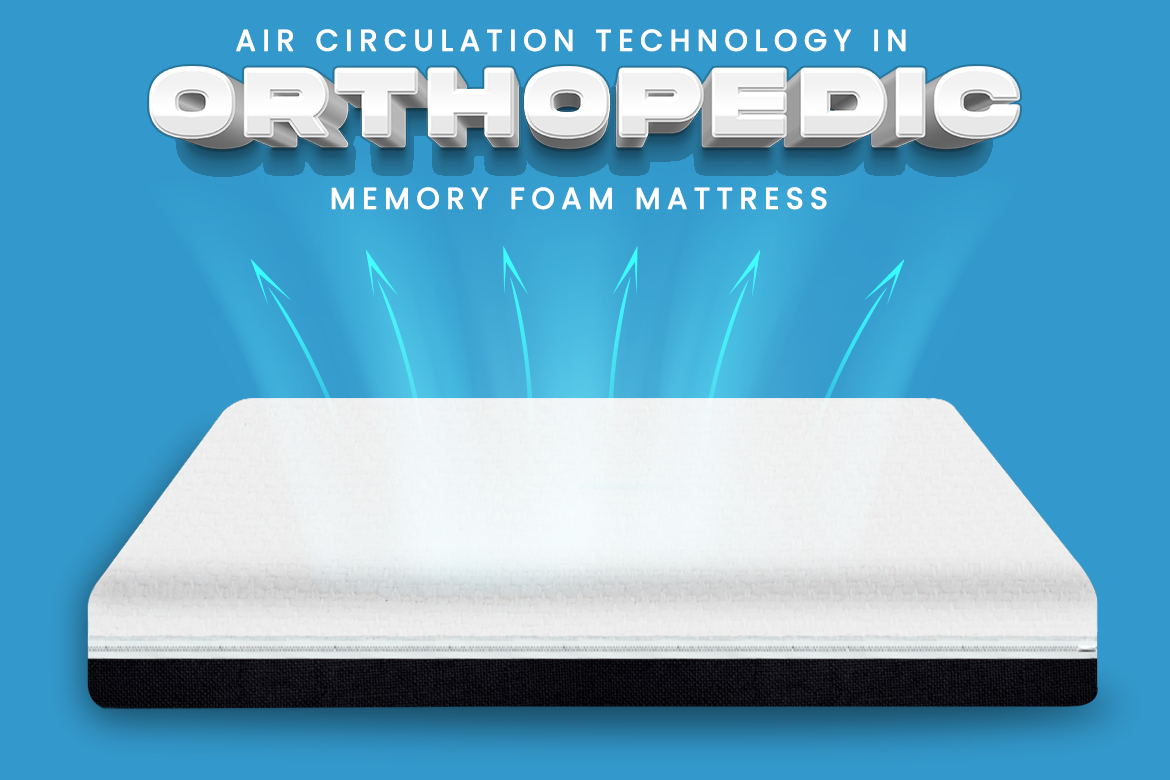
We all need a good night’s sleep for our general health and well-being. It not only revitalizes our physical bodies but also improves our mental and emotional health. The mattress we sleep on is one of the main elements that has a big impact on the quality of our sleep. For healthy sleep, a sturdy and comfortable mattress can make all the difference.
Orthopedic memory foam mattresses have gained tremendous popularity in recent years due to their ability to provide optimal comfort and support. These mattresses are specifically designed to promote proper spinal alignment, alleviate pressure points, and reduce the likelihood of waking up with aches and pains. They provide a unique and comfy sleeping surface by molding to the contours of the body.
Nevertheless, despite the advantages of memory foam, controlling body temperature while sleeping is a regular problem. Memory foam mattresses frequently retain body heat, which causes pain and sleep disruption. This is where air circulation technology comes into play. Orthopedic memory foam mattresses use air circulation technology to reduce heat retention and create a cooler sleeping environment. These mattresses improve air flow, eliminate unnecessary heat, and improve sleeping comfort by utilizing cutting-edge technologies and materials.
In this blog post, we will delve into the significance of air circulation technology in orthopedic memory foam mattresses. We will also explore how this technology works, its benefits, and the factors to consider when choosing a mattress with air circulation features.
Significance of Air Circulation Technology in Orthopedic Memory Foam Mattress And How It Works
Air circulation technology plays a significant role in an orthopedic memory foam mattress by enhancing temperature control and ventilation. It has cutting-edge technologies and mechanisms to improve ventilation, remove extra heat, and produce a cooler sleeping environment. The basic idea behind air circulation technology in orthopedic memory foam mattresses is to provide pathways for air to move through the mattress. This is accomplished through a number of technologies and design features created especially to improve ventilation and reduce heat accumulation.
One important component of air circulation technology is the integration of ventilation channels or perforated layers within the mattress. These channels are intentionally positioned all over the mattress to promote better airflow. This convoluted foam design improves airflow and heat dissipation, ensuring a cooler sleep surface. By incorporating ventilation channels, orthopedic memory foam mattresses provide a comfortable temperature throughout the night.
The use of an open-cell foam structure is another crucial component of air circulation technology. Air circulation technology-based mattresses have an open-cell foam architecture, as opposed to conventional memory foam mattresses, which have a closed-cell structure. Better airflow and heat dissipation are made possible by the open-cell structure, which keeps heat from being trapped inside the mattress.
In air circulation technology, the selection of a breathable mattress cover or fabric is also crucial. Orthopedic memory foam mattresses frequently include breathable fabric covers made of natural fibers. These covers enhance ventilation and temperature control by allowing for greater airflow and moisture evaporation.
Orthopedic memory foam mattresses may also have cutting-edge cooling gel or phase-change components. Typically, cooling gel is incorporated into the foam layers to absorb and release extra heat and help control the mattress’ temperature. Phase-change materials have the unusual property of absorbing and releasing heat as they go through a phase transition, keeping the temperature comfortable all night. These materials aid in maintaining a more balanced sleep environment and guard against overheating.
Benefits of Air Circulation Technology in Orthopedic Memory Foam Mattress
Orthopedic memory foam mattresses with air circulation technology (ACT) have a number of advantages that make for more pleasant and restful sleep.
Improved Temperature Regulation:
A cooler sleep surface is produced through ACT’s improved ventilation and heat dissipation, which results in improved temperature regulation. This assists in controlling body temperature and lowers the chance of overheating while sleeping.
Reduced Discomfort:
ACT helps minimize the buildup of moisture and humidity inside the mattress by encouraging greater air circulation. This lessens the possibility of discomfort brought on by excessive perspiration or a wet sleeping environment.
Better Sleep:
The ACT-created cooler and more comfortable sleeping environment help with better sleep. Sleepers are less prone to wake up from discomfort, overheating, or restlessness, leading to more undisturbed and restorative sleep.
Improved Breathability:
The incorporation of ventilation channels, perforated layers, and open-cell foam structures enhances breathability, allowing for the free flow of air through the mattress.
Increased Mattress Lifespan:
Effective air circulation lessens the possibility of moisture retention and the development of mold, mildew, or bacteria that produce odors. This can help the mattress last longer and keep its cleanliness and freshness over time. Furthermore, air circulation technology in orthopedic memory foam mattress helps you to get relief from dust allergy.
Factors to Consider When Choosing a Mattress with Air Circulation Features
The following are some important aspects to take into account when choosing a mattress with air circulation features:
Breathability:
Air circulation technology makes sure that fresh air can flow through the mattress, minimizing the buildup of heat and moisture. Look for mattresses made of breathable materials that allow air to flow freely and release body heat, such as open-cell memory foam or latex.
Ventilation System:
Look for mattresses that have a well-designed ventilation system. This can include features such as air channels or perforations
Heat Regulation:
Controlling the temperature is a crucial component of air circulation. Look for mattresses with integrated cooling technologies.
Moisture Management:
Airflow is important for regulating moisture in mattresses. Mold, mildew, and allergies can grow as a result of moisture buildup, which can have a negative impact on one’s health and quality of sleep. Pick mattresses with moisture-wicking capabilities to reduce moisture buildup and encourage a dry sleeping environment.
The air circulation technology in orthopedic memory foam mattresses is a powerful component. In addition to enhancing breathability, it promotes temperature control, moisture management, pressure alleviation, and mattress longevity. You can create the optimal sleeping environment that fosters comfort, support, and general well-being by taking these variables into account and choosing a mattress with efficient air circulation features.

